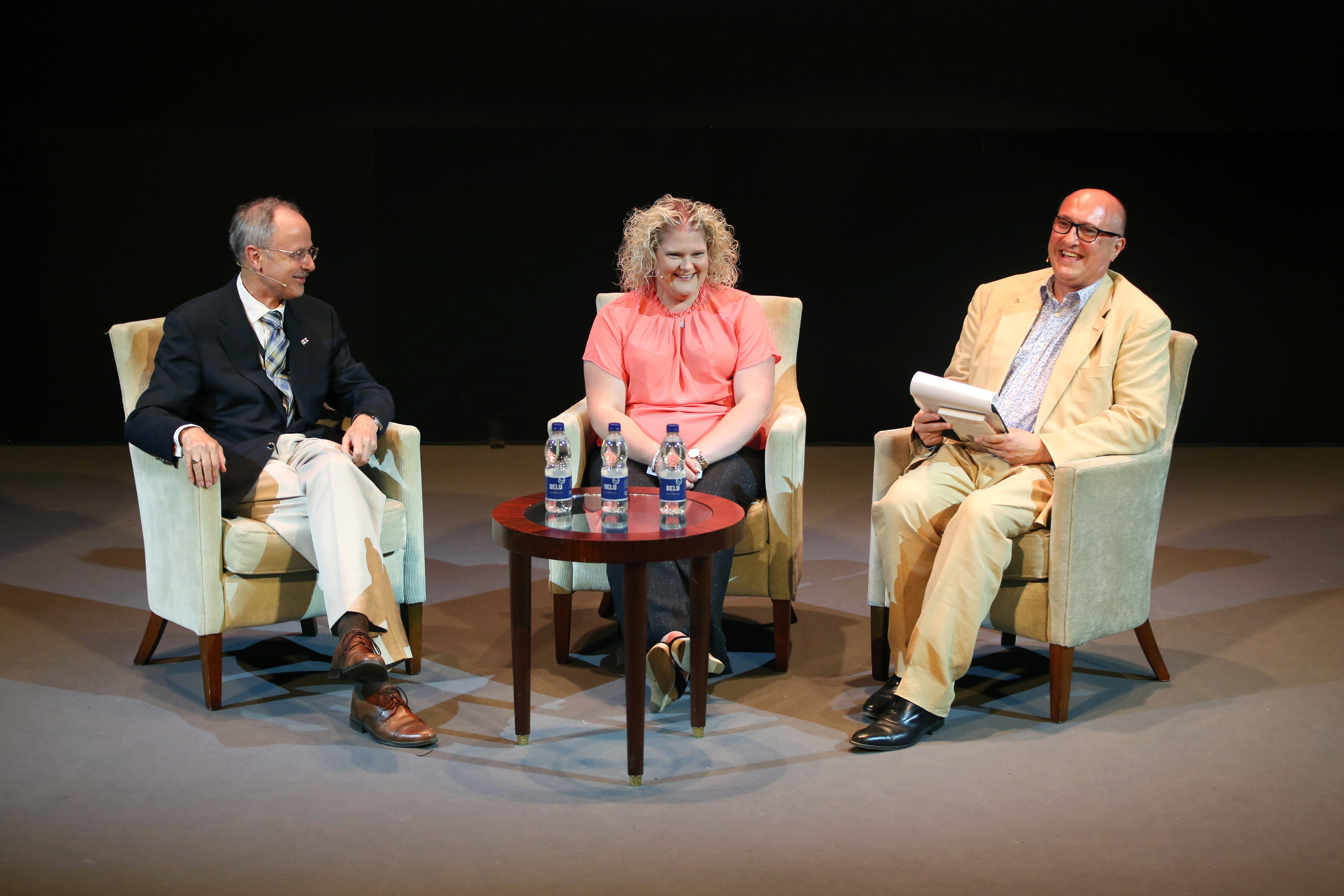‘It’s very weird to think I started off life in that tiny dish.’
That was how the world’s first ‘test tube baby’, Louise Brown, referred to her glass incubator that features in our new exhibition, IVF: 6 Million Babies Later, at a special IMAX event last night, on her 40th birthday.
One of several IVF events at a Lates attended by 3,500 people to mark her birthday, the birth of the reproductive science revolution, and the 70th birthday of the NHS, it began with Louise Brown watching a film of herself being born.
Among the packed audience was John Webster, an obstetrician and gynaecologist who was present at her birth, many others conceived by IVF, fertility specialists and the public.
With me and Louise on the IMAX stage was Professor Roger Gosden, who began his academic medical research career under Sir Robert Edwards, who won the Nobel prize for his work on IVF, developed with Patrick Steptoe, a gynaecologist and innovator in the field of laparoscopy (keyhole surgery) and Jean Purdy, who some regard as the first clinical or IVF human embryologist.
Louise Brown began by telling us about the path her parents took to begin their IVF journey. ‘All mum wanted was a baby…she would have done anything.’ Later in the event, she added that when she held her own son in her arms, ‘I realised what my mum meant when she said that she really wanted a baby’.
The scientific background to her birth was given by Roger Gosden, along with a surreal anecdote about warming sausage rolls in equipment used in the research that culminated with him asking Louise if she had an unusual penchant for the British savoury pastry snack.
The birth of Louise just before midnight on 25 July 1978, was a defining moment for reproductive technology pioneered by British researchers. Louise’s birth followed ten years of experimentation, hundreds of failed attempts and many setbacks, involving hundreds of women.

John Webster described the sense of anxiety among the team as mum-to-be Lesley Brown was wheeled into operating theatre. The stakes were high, and tension was exacerbated by film cameras in the theatre.
Doctors of the day thought that IVF was a risky idea driven more by an appetite for headlines than scientific curiosity. And yet knee-jerk revulsion would give way to acceptance when the public and the science funding bodies became aware of the benefits for infertile couples.
Louise entered the world with a cry. Within hours, her ‘miraculous’ birth became worldwide news and has changed the future of human reproduction.
Steptoe, Purdy and Edwards, after two failures, managed to produce the second child, Alastair MacDonald. Prof Gosden added that he only recently discovered that Purdy herself was infertile, with endometriosis.
The Browns would go on to have another IVF child, Natalie, the 40th IVF baby and first to have her own child, conceived naturally.

Louise Brown told the audience that Bob Edwards and Patrick Steptoe were like extended family. ‘I will always be grateful to them for giving me life and 6 million others too.’ Jean Purdy died of malignant melanoma when Louise was seven.
Louise was 14 when she realised the significance of how she came into the world and tells her own story in her book, Louise Brown: 40 Years of IVF, written with Martin Powell.
During the event, the 14-day rule that governs human embryo research was discussed, in the context of now being able to grow embryos for longer than ever before, as a result of research by Prof Magda Zernicka-Goetz in Cambridge, along with the future of embryo research, from artificial eggs and sperm to artificial embryos.
Louise Brown admitted to the audience that she had already had Happy Birthday sung to her on four continents. The IMAX event ended with the acclaimed singer, pianist and songwriter Joe Stilgoe improvising mash up versions of ‘Happy Birthday’ with songs by her favourite group, Take That, and the record that was number one in the charts when she was born: ‘You’re the One that I want’, by John Travolta and Olivia Newton-John. You can hear the mash-up below.
Afterwards, a special birthday party was held in the IVF: 6 Million Babies Later exhibition, along with curators, Connie Orbach and Ling Lee.
With them was Jenny Joy (Robert Edwards’ daughter) and family; Grace MacDonald, mother of second IVF baby, Alistair MacDonald, conceived in Oldham but born in Glasgow; Martin Johnson, former PhD student of Robert Edwards and Emeritus Professor of Fertility Sciences at Cambridge University; Kay Elder, clinical assistant to Patrick Steptoe in Bourn Hall from 1984; Aileen Feeney, Chief Executive of Fertility Network UK plus many of their staff; IVF patients who contributed to the exhibition and whose stories appeared within the exhibition; Director of the Progress Educational Trust Sarah Norcross and team; Dr Kamal Ahuja, director of London Women’s Clinic and members of his team; Natalie Silverman, presenter of the Fertility Podcast; and staff from the Guy’s Hospital Assisted Conception Unit, Herts and Essex, Fertility Centre, the Lister Fertility Clinic and CARE fertility.
After yet another round of singing happy birthday, I presented a card and cake to Louise on behalf of the museum. The audience were given cupcakes decorated with images of human embryos produced in the laboratory of Magda Zernicka-Goetz, which highlights early stages of human development with colourful labelling methods. Julian Hitchcock, who was the lawyer of Edwards, remarked they were ‘Pretty tasty, too.’
Explore the remarkable story of in vitro fertilisation from the opposition and immense challenges faced by early pioneers to the latest research today in IVF: 6 Million Babies Later in our Who Am I? gallery. Find out more.